Last blog we promised to show you that we only use the energy we need. First, we show the use of our equipment in the galley, the ship’s kitchen.

Heating water
Before Ya, we always used a kettle and a gas stove to heat the water for our coffee and tea. The heat of the flame and fumes go around the kettle and… are still hot over the kettle. That heat is all lost.
Now we use a water heater, a cooker. Let us have a look:
- If you poor water in, you see a level meter. So, you only cook the water you need.
- The heating element is built in the bottom, not at the side.This way it gives all the heat to the water to be cooked. So, you only use the energy you need.
- The body of the heater and the lid are double skinned: insulation. The heating process does not lose heat to the outside.
- It cooks fast, so there is hardly time to ‘leak’ heat.
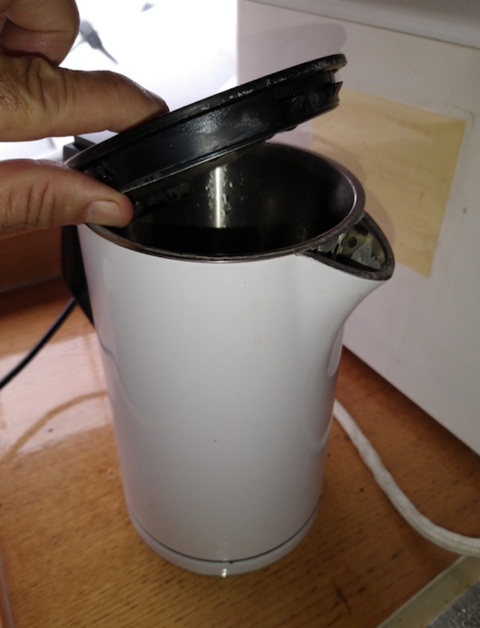
Compared to the kettle on the gas stove, we save about 80% of the energy. While we only use what we need with the electric heater, most of the energy created by the gas combustion, ends up in the form of steam. You cannot use it to heat up your room, because the steam consist of water damp and CO2. So, this means you must ventilate your room well, for your own health and to keep your room free of moisture.
Cooking with induction and hay box
The induction cooker is high tech. The induction technique gives energy through a (safety) glass to the steel bottom of the pan, and then that pan bottom gets hot. That place is exactly the place where you need the heat. The induction cooker saves you about 50 to 55% of the heat if you compare it with cooking on gas stoves or the old-fashioned electric heating stoves.
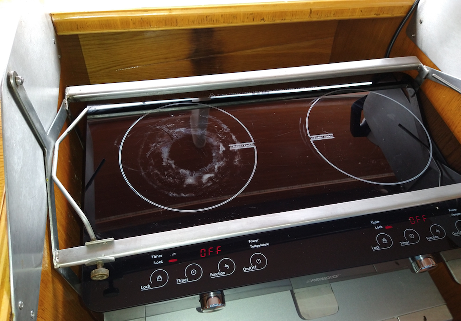
But we can do better. We go from high to low tech. In Grandma’s time, before we had the overflow of fossil fuels, everybody was careful with the fuels, because they were expensive. So, Grandma cooked her rice and vegetables in a pan, and the moment it was hot, she took it from the fire and the pan went straight in the ‘hay box’
The hay box was a box with hay. It insulates. It keeps the heat in the pan. The rice or vegetables were cooked slowly. Most food is cooked in 1/3 extra time compared to the time it takes when you cook it on a stove. If you start cooking the things that need most time, you don’t lose any time.
On a moving ship it has the extra advantage that the hot pan stays in a safe place.
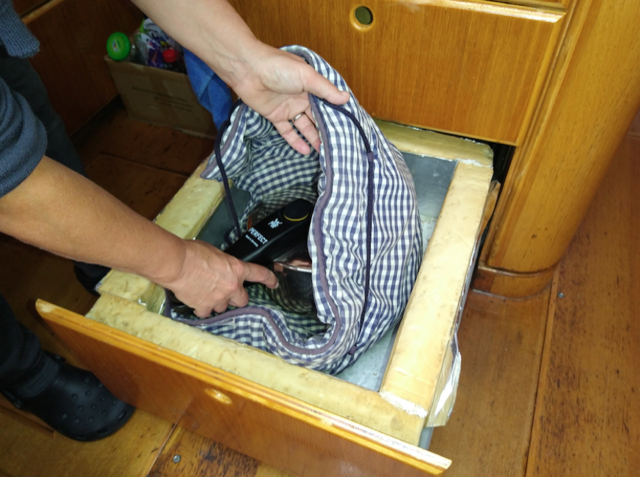
We modernized it a bit. We took PIR foam, put it in a drawer, and with the pan inside we cover it with a ‘Hooimadam’, a cotton cover filled with good old-fashioned wool. This modern ‘hay box’ saves us energy again. We save another 30%.
And finally, as we showed you some blogs ago, we use a pressure cooker to speed cooking up just a bit more, and save even more time and energy on cooking.
So, when we cook with the induction cooker, pressure cooker and hay box we can easily use 20% of the energy we used in the old, fossil days. That’s a reduction of, indeed: 80%.
How much do you use at home?
Heating up in the micro wave
About 70% of the electricity is converted to little radio waves. These radio waves make water molecules move. By moving and colliding, there is friction, and friction makes heat.
It means that the water in the food gets hot. Water is generally the main part, so your food gets hot ‘from the inside’.
This is ideal to heat up food. Because you don’t have to heat up a pan first. And, when mixing the hot and cold food in a pan, the lid is off, so much of the heat flies away.
Instead, the microwave uses 70% of the electricity input to really heat up your food. That is a loss of only 30%. And the job is done quickly.
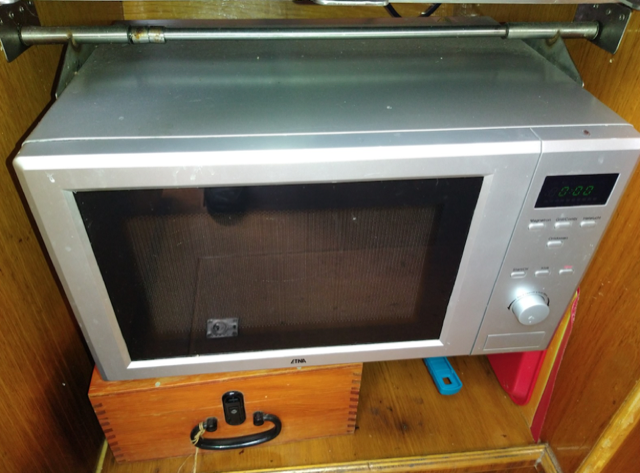
Bread baking machine instead of an oven
For small, private use, the oven is a real energy consumer. But we like fresh baked bread. That is why we use a bread baking machine.
The old-fashioned way with kneading the dough, etcetera, costs a lot of work and energy. Not with the bread baking machine. You simply put the water, flour, salt, yeast et cetera in the pot, push some buttons and off the machine goes.
The machine itself is closed, double skinned, is economic on the heat, so, it uses only what it needs to make the bread.
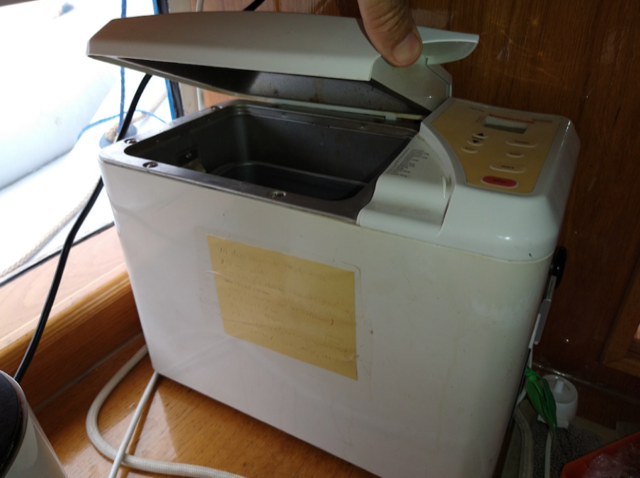
The fridge and the freezer
If you only want to use what you need when cooling (and heating), only 3 things are important:
- Insulation
- Insulation
- Insulation
So that is what we did. Our refrigerator is surrounded by a 15 centimetre pack of PIR foam. The bottom has more than 20 cm of PIR insulation, and the lit, where the cold exchange is less, only 8. Now the cold stays en and we only use a tiny bit of energy. So little, that we even don’t notice it in our energy household.
In the tropics and subtropics, the 50 Watt equipment runs on 3 to 4 times an hour for 6 minutes. For the 35 litre fridge we note about 2-4 degrees Celsius, and for the 25 litre freezer we sometimes hit the 11 degrees.
Please don’t believe designers automatically design a good fridge or freezer for you. They ‘economize’ on the insulation, to ‘give’ you more space inside. So, then you need a really powerful cooling device. The designers may well design this thing right under your refrigerator. So, the heat exchanger under it heats up your fridge again. To get all this idiotic power design effective, the cooling equipment has to be extremely powerful: about 4 or 5 times stronger than what we need for our complete fridge and freezer.
Sorry to tell you, but on the market, we only found bad ‘energy-guzzling’ refrigerators and freezers. On sailboats you see that some skippers, aware of their limited energy and batteries, have become the slave of their own badly designed fridges. They run the engine 2 times a day to make electricity. Or they buy an enormous surface of solar panels, to compensate for the loss of energy by the fridge. Energy wise, it is like filling up a colander with water.
This is why some yachties simply stopped using fridges. A pity! We love cold yoghurt, a cool beer, and tapas. So, we cool only what we need.
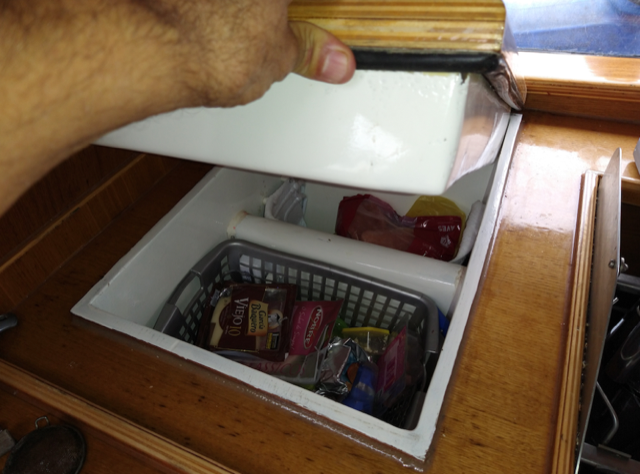
The extra comfort of using only what you need.
Our galley, our kitchen, is widely appreciated for its comfort. Making tea water is done 3 times quicker than usual. The induction cooker is easy to use and safe. The microwave is convenient for heating food quickly, and the bread baking machine is a joy.
We have no gas, so no moisture getting into your upholstery. It brings comfort.
We have no danger of too much fumes in a small space. We have no gas, so no risk on explosion or fire. So, this is safer.
And by the way, we have no costs for the gas, and all equipment is cheaper or equally expensive as gas equipment. We did need to make a first investment in an inverter, that converts our battery power to the 230Volt that all the equipment needs. If you count the costs of the gas bottles you will use for many years, you will probably find a break even point.
And on top of being pleasant, more comfortable, safer and cheaper, it is better. It is the ethical thing. This way, we can live now without compromising the future of our children, of all next generations.Like most people, we like to use things.
But not more. We only want to use what we need.
You might also enjoy:
https://www.noonsite.com/report/insights-how-to-save-energy-when-cooking-onboard/
